
* The success of the Harrier and Sea Harrier led to a second-generation version of the type, the "Harrier II", with development driven by the US. The Harrier II would prove a worthy and more capable successor to the early Harriers, and remained a useful military asset into the early 21st century.
* The Harrier was the result of a compromise. The original intent to build a VTOL combat aircraft was focused on the supersonic P.1154 concept, but when that fell through, the existing Kestrel was all that was available; the British took it and turned it into a warplane. Although it had unique capabilities, users were never entirely happy with its limited range and warload. There was definitely room for improvement.
In 1973, British Aerospace and McDonnell Douglas conducted a set of conceptual studies for a bigger and better Harrier, the result of which was the "AV-16A" or "AV-8X", based on the bigger and more powerful Pegasus 15 engine, with plenum-chamber burning. The informal "AV-16A" designation reflected the goal of an aircraft with twice the range and twice the warload of the existing AV-8A. There was also some interest in supersonic performance.
There were a number of potential users for such a new aircraft in branches of both the British and American armed services, but in 1975 the British government zeroed out UK participation. The sticking point appears to have been development costs for the Pegasus 15, coupled with government funding constraints on both sides of the Atlantic. The Pegasus 15 project was abandoned and the international collaboration between MDD and BAE fell apart, for the moment.
* That meant in practice that future development of the Harrier had been handed over to MDD. The US Marine Corps liked their existing AV-8As and were sufficiently interested in enhancements, specifically better range and payload capability, to give MDD reason to proceed with the development of an improved Harrier, the "AV-8B". This improved Harrier was more modest than the AV-16A concept, but still added significant improvements, such as a bigger new wing and extensive use of composite materials.
The first two "YAV-8B" prototypes were simply AV-8As with the new composite wing. The first one performed its initial flight on 9 November 1978. Flight tests performed in 1979 provided enough proof of the value of the improved wing that MDD obtained a contract for four development aircraft. However, the Carter Administration made it very clear that the USMC would only get the new aircraft if a "major foreign buyer" (meaning "the UK") was found.
The RAF had been considering in parallel a Harrier upgrade proposed by British Aerospace called the "Big Wing" Harrier. This involved a new and bigger wing made of metal and was also known as the "Tin Wing" Harrier. The wing would have been retrofitted to existing Harrier GR.3s and Sea Harriers. However, in 1980 the RAF evaluated the AV-8B design to see if it would meet their requirements instead. The RAF's biggest concern with the AV-8B was that it could not turn quickly enough to defend itself in air combat; in response, MDD added "leading-edge (wing) root extensions (LERX)", short wing extensions along the air intakes that created vortexes over the wing surface to enhance maneuverability. LERX was fitted to the second development aircraft. The idea was borrowed from the Big Wing Harrier design.
Placated, the British agreed to come on board. The British offered to contribute $80 million USD for general development and $200 million USD for development of features related to their own needs, and to buy at least 60 of the new aircraft. Construction of airframe elements was divided between MDD and BAE, with no overlapping production of components.
The first true AV-8B prototype flew on 5 November 1981, with the other three prototype machines flying by the following summer. The first production aircraft flew on 29 August 1983, and the type began to enter operational service at the end of the year, finally displacing all the AV-8Cs by 1987. The USMC eventually purchased 200 AV-8Bs. There was some consideration to fitting the new composite wing or some modification of it to first-generation Harriers, but that proved impractical.
BACK_TO_TOP* The AV-8B incorporated many significant improvements, some of which were externally visible, some of which were not. The new "supercritical" composite wing was bigger, by 2.69 square meters (29 square feet), and had reduced sweep, 36 degrees instead of 40. The landing-gear outriggers were moved inward from the wingtips to the middle of the wing. Composites were also extensively used in the construction of the fuselage. The new wing allowed the AV-8B to roughly double the warload of its predecessors, up to 4.2 tonnes (4.6 tons). That was about the same as the old Boeing B-17 Flying Fortress bomber, quite a vindication of the Harrier against critics who had claimed that it would never be able to carry any payload heavier than a pack of cigarettes.
The number of stores pylons was increased from four to seven, with one on the fuselage centerline and three under each wing. Four of the pylons were plumbed for carrying external tanks, and the pylon near each wingtip was wired for a Sidewinder AAM or, using a double launch rack, a pair of them. There were modest changes in the air inlets and exhaust nozzles. The engine was an uprated variant of the Pegasus 104, the "Pegasus 105" (US-built as the P&W "F402-RR-406") with almost 98.1 kN (10,000 kgp / 22,000 lbf) thrust, as well as digital engine controls. The crude-but-effective bolt-on refueling probe was replaced with a retractable probe on the upper side of the left air inlet; this new probe could also be removed if desired.
___________________________________________________________________
BAE / MDD AV-8B HARRIER II:
___________________________________________________________________
wingspan:
9.25 meters (30 feet 4 inches)
wing area:
22.18 sq_meters (238.7 sq_feet)
length:
14.12 meters (46 feet 4 inches)
height:
3.55 meters (11 feet 8 inches)
empty weight:
6,336 kilograms (13,968 pounds)
MTO weight (STO):
14,060 kilograms (31,000 pounds)
MTO weight (VTO):
8,595 kilograms (18,950 pounds)
max speed, sea level:
1,065 KPH (660 MPH / 575 KT)
service ceiling:
15,240 meters (50,000 feet)
ferry range:
3,640 kilometers (2,265 MI / 1,965 NMI)
combat radius:
1,000 kilometers (685 MI / 595 NMI)
___________________________________________________________________
Despite the uprated engine and the lower weight, the AV-8B was about 80 KPH (50 MPH) slower than the AV-8A. The Marines didn't care. They wanted a "bomb truck" with greater payload and endurance, not a "hot rod". In compensation, the AV-8B was more agile in air combat than the AV-8A.
The Marines had not thought it worthwhile to replace the twin 30-millimeter Aden cannon fitted to their AV-8As, but it was a nuisance stocking ammunition for the Adens since no other Marine weapon used them, and their rate of fire was also on the low side. The Aden cannon were finally replaced by a single five-barreled 25-millimeter pneumatically-operated Gatling gun, the "GAU-12/U", with a maximum rate of fire of 3,600 rounds per minute and a muzzle velocity of 1,070 meters per second. The weapon itself was stored in one gun pod while the other gun pod contained 300 rounds of ammunition, with a feed tunnel between the two. When the gun pods were not fitted, they were replaced by a pair of fins known as "lift-improvement devices (LID)".
The AV-8B was fitted with a Sea-Harrier-like raised canopy, with a one-piece wraparound windshield, providing much improved field of view. The pilot sat in a UPC-Stencel Type 10B ejection seat. The cockpit was completely revised. The first-generation Harrier's cockpit was sometimes called an "ergonomic slum", but the Harrier II's new "digital" cockpit was state of the art, based on that of the MDD F/A-18 Hornet. It featured a large HUD and HOTAS controls.
New avionics included a stability augmentation system to make the machine easier to fly, plus a new attack system, the Hughes "AN/ASB-19 Angle Rate Bombing System (ARBS)", which had been proven on the McDonnell Douglas A-4M Skyhawk. ARBS combined a laser spot tracker and TV imager working in concert to provide highly accurate targeting capabilities. System avionics incorporated fiber-optic connections, the AV-8B being one of the first operational aircraft to have such a feature. Defensive systems included two AN/ALE-39 chaff-flare dispensers, an AN/ALR-67 RWR, and the ability to carry an AN/ALQ-126C jammer pod. 174 AV-8Bs were built for the USMC.
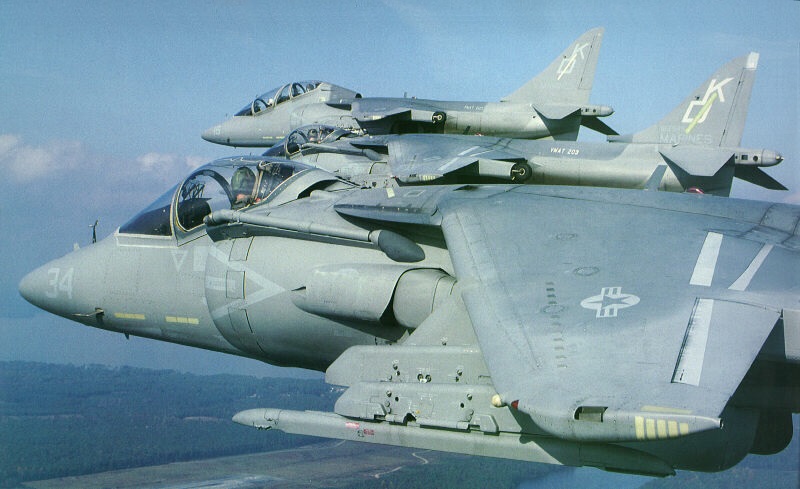
* As with other Harrier variants, a two-seat conversion trainer, the "TAV-8B", was produced as well, the first flying on 21 November 1986. The TAV-8B had a taller tailfin and only a single stores pylon under each wing. Unlike other Harrier two-seaters, it didn't have an extended tailcone. A total of 22 TAV-8Bs was delivered to the USMC.
* The AV-8B was followed by a modest update, the "Night Attack Harrier II" or "AV-8B(NA)". A stock AV-8B was modified as the prototype, with initial flight in its new configuration on 26 June 1987. As the "Night Attack" name suggested, the update provided enhancements for night operations, most importantly a GEC Sensors "forward-looking infrared (FLIR)" imager, housed in a tab on top of the nose, that displayed infrared imagery on a wide-angle HUD. Other changes included:
The AV-8B (NA) went into service in September 1989. The new Pegasus 11-61 engine proved to have a bug, with the titanium blades scratching the engine walls under certain circumstances, starting an engine fire. This problem had been encountered before, with the P.1127; it was fixed by replacing the titanium blades with steel blades. 61 new-build Night Attack Harrier IIs were built for the USMC.
BACK_TO_TOP* The AV-8B(NA) led in turn to the "AV-8B+" AKA "Harrier II Plus", the first US Harrier with a radar system -- Hughes AN/APG-65 multimode radar, developed for the F/A-18 Hornet. Costs of the upgrade were shared with Spain and Italy, who were interested in obtaining the type. First flight of the AV-8B+ prototype, modified from a stock AV-8B, was on 22 September 1992.
The AN/APG-65 was a compact, all-digital unit that provided multiple modes for air-to-air and air-to-ground combat, including such capabilities as "track while scan" and terrain-following navigation. While the AV-8B+ was given a longer nose to accommodate the radar, it still had to be fitted with a smaller antenna than that used in the F/A-18 to fit. The radar also had to be given software changes and a new circuit board, but the changes did little to degrade radar performance.
The AV-8B+ featured other modifications as well, such as the addition of a Sidewinder launch rail on the outrigger landing gear fairing. This idea, as explained below, was invented by the British for their Harrier IIs, and gave the aircraft nine effective stores pylons. The AV-8B+ also had a distinctive lengthened ram-air intake at the base of its tailfin. 27 Harrier II Plus new-build aircraft were produced for the USMC, with 72 upgrades from older types delivered into 2003. The USMC TAV-8Bs were upgraded to make them more representative of the AV-8B+ standard.
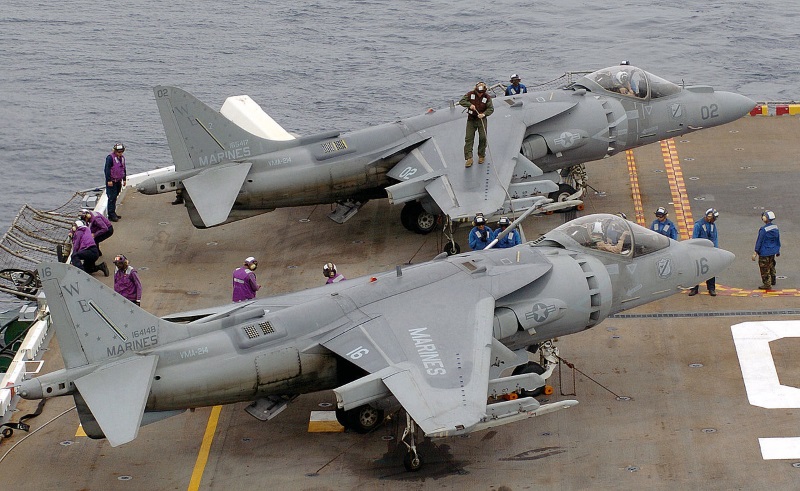
With the acquisition of McDonnell Douglas by Boeing in 1998, the AV-8B family has, at least technically, become the "Boeing Harrier II". Boeing never built any Harriers, however: the Saint Louis production line was shut down and dismantled.
* In the late 1990s, the AV-8B+ was qualified to carry the Israeli-designed Rafael / Northrop Grumman Litening targeting pod, featuring:
The USMC continued to obtain later versions of the Litening pod and improve their integration with the Harrier II, with Harrier IIs carrying Litening used for night reconnaissance. From 2003 Marine Litening pods were fitted with a radio datalink to allow them to relay imagery to ground troops or other users.
BACK_TO_TOP* The AV-8B was also the focus of a number of export sales. The Spanish Navy, having had good experience with their AV-8S Matadors, bought 12 "EAV-8Bs" for their new carrier, PRINCIPE DE ASTURIAS, with the aircraft assembled by CASA; they went into service in 1987 and 1988.
Spain then obtained 8 "EAV-8B+" machines in 1996, with five of the nine surviving EAV-8B machines upgraded to a similar spec. An effort was made to upgrade the remaining four, but money ran out, and these four machines were retired in 2014. After attrition, the Spanish Navy had 12 single-seat Harrier IIs, plus a single TAV-8B trainer acquired in 2000, operating off the newer carrier JUAN CARLOS I.
Similarly, the Italians obtained a useful naval air capability by purchasing 16 AV-8B+ fighters and two TAV-8Bs for their new carrier, the GUISEPPE GARIBALDI. Incidentally, adopting the Harrier II required some changes in Italian law, since the Italian Navy could only fly helicopters, not fixed-wing aircraft. The TAV-8Bs and three AV-8B+ machines were built in the US, with the other 13 AV-8B+ machines assembled by Alenia.
They have been given modest upgrades in service, mostly for weapons carriage, as well as carriage of the Litening targeting pod. The USMC ended up in some squabbles with the Spanish and Italians over Harrier II weapons qualification. Although the new AN/APG-65 radar of the AV-8B+ was capable of supporting BVR air combat using AMRAAM, or "over the horizon" surface attack using the AGM-84 Harpoon antiship missile, the Marines were slow to qualify AMRAAM and showed little interest in qualifying the Harpoon, antiship attack not being an ordinary USMC mission.
The Spaniards and Italians did want these capabilities, and in fact apparently believed when they helped fund the integration of the AN/APG-65 to the Harrier II that adding such capabilities was the specific point of the exercise. AMRAAM was finally qualified for use by Spanish and Italian Harrier IIs through a software upgrade to the AN/APG-65, and photos of their Harrier IIs carrying AMRAAMs are not unusual; the USMC didn't get around to announcing qualification of AMRAAM until 2009. Some sources claim the Harpoon was finally qualified, but if so details are hard to find, as are pictures of a Harrier II carrying Harpoons.
The Italian Harrier II force served in air actions and patrols over the Balkans in the 1990s, as well as in Iraq, Afghanistan, and during the NATO intervention in Libya in 2011. Spain's Harriers II did fly over the Balkans, but the Spanish preferred to use their Hornet fighters in later interventions.
* USMC Harrier IIs have seen plenty of combat. The Marines fielded two ground-based Harrier II squadrons to the Gulf War in early 1991, the type being one of the first USMC aircraft into action. They also flew a detachment operating off the assault ship USS SAIPAN. A total of 86 AV-8Bs was committed. The AV-8B(NA) was still being introduced at the time and did not participate.
USMC Harrier IIs performed 7.7% of the sorties in the war. Their effectiveness met the expectations of their owners, though five were lost. They flew missions with standard "dumb" ordnance, including general purpose high-explosive bombs, napalm bombs, and cluster bomb units, as well as "smart" weapons such as laser-guided Maverick missiles. "Buddy" laser designation was provided by OV-10 Bronco and later F/A-18D Hornet forward air controllers, since the USMC Harrier IIs did not have such a capability at the time.
Although the Harrier IIs had their detractors in the USMC who pointed to the losses as indicating the type's vulnerability -- with the four-nozzle exhaust configuration giving heat-seeking missiles a dead-center target -- General Norman Schwarzkopf, the Coalition theater commander, claimed it was one of the nine weapons that won the war, the other aircraft in the list being the AH-64 Apache helicopter and the F-117 Stealth Fighter.
The Marine Harrier II fleet fell into a certain neglect during the rest of the 1990s, but it was revived enough to provide support for the Afghanistan campaign in the winter of 2001:2002, operating from the assault ship USS PELELIU at sea and performing strikes with dumb bombs, backing up Marine special operations forces operating in the country. USMC Harrier IIs also fought in the US invasion of Iraq in the spring of 2003 and made good use of their new Litening pods, employing them for both targeting and reconnaissance. The video-feed upgrade was very handy, since it allowed forward air controllers to see what the Harrier II pilots were seeing, and tell the pilots where friendly and hostile forces were -- though only three pods had the feed upgrade at the outset, and they were in great demand.
The Marine Harrier IIs operated from forward bases in Iraq behind the battle lines and were capable of responding to requests for air support within minutes. Mission-capable rate was almost 80%, demonstrating that the USMC's work to bring the Harrier II up to spec had been successful. The general consensus in the USMC was that the Harrier II's service in the "Second Gulf War" was outstanding.
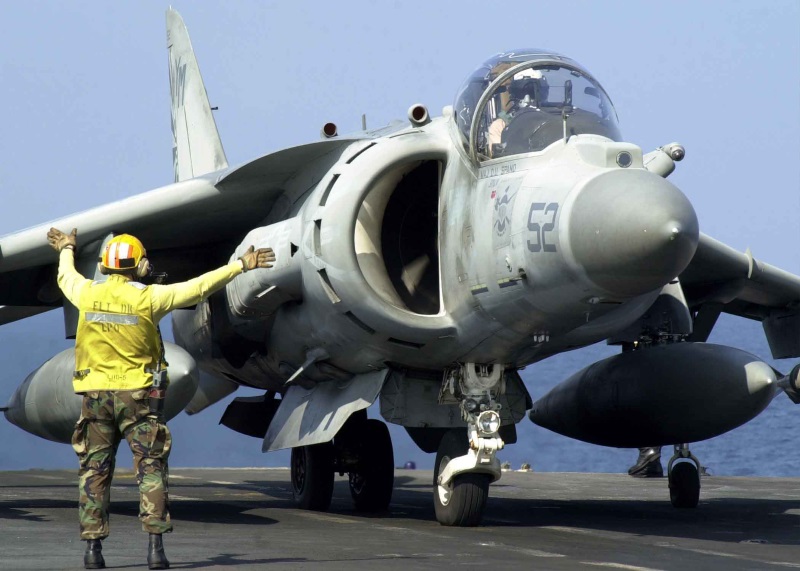
Marine Harrier IIs performed combat duties in Afghanistan and Iraq during the remainder of US operations there. The Marine Harrier II force did suffer losses in action, with six Harrier IIs and a C-130 Hercules destroyed, along with two Harriers damaged, by Afghan insurgents in a well-planned raid on Marine Camp Bastion on 14 September 2012, the insurgent assault team being dressed in US uniforms. More Marine Harrier IIs were flown in to replace the lost machines in operations.
A handful of Harrier IIs operated against Libya in 2011 as part of NATO operations in support of the popular rebellion there, these aircraft operating off the assault ship USS KEARSARGE. They returned to Libya in 2016, with Harrier IIs flying from the USS WASP in the Mediterranean performing strikes on Islamic State (IS) insurgents on behalf of the Libyan government. Marine Harrier IIs flying from the USS BOXER in the Persian Gulf similarly assisted in strikes on IS insurgents in the Syria-Iraq theater in that same year.
The USMC is phasing out their Harrier II force in favor of the F-35B STOVL JSF -- but F-35B deliveries have been slow, and the Marines say the Harrier won't be fully retired until 2029. Italy, incidentally, is also replacing their Harrier IIs with F-35Bs, and it is plausible Spain will as well. Marine Harrier IIs were given further updates, with a program started in 2015 that provided:
The Marines wanted to obtain a helmet-mounted sight for their Harrier IIs, but it didn't happen. However, there were software upgrades, and improved munitions and other stores have been qualified. One particularly useful store that was qualified was the "Intrepid Tiger II" electronic warfare (EW) pod, introduced to service in 2012. It was developed to allow the Harrier II to jam cellphones used to detonate roadside bombs and adversary tactical communications.
Another useful store, introduced to the Harrier II in 2016, was the "Advanced Precision Kill Weapon System (APKWS)", which is a classic 70-millimeter (2.75-inch) unguided rocket with a laser-seeker module added. APKWS gaves the Harrier II the ability to carry a large number of potent guided munitions with a "low collateral damage" warhead.
BACK_TO_TOP* The British equivalent of the AV-8B was the "GR.5", the designation originally given to the unbuilt "Big Wing" Harrier. The GR.5 as it was actually built was generally similar to the AV-8B, but with many detail changes. The GR.5's changes from the AV-8B configuration ended up being uncomfortably expensive and were criticized, with the response being that the RAF had different requirements than the USMC, and the changes were needed to allow the aircraft to meet RAF operational needs.
Instead of one 25-millimeter Gatling gun, the GR.5 was to be fitted with twin new-design 25-millimeter Aden revolver cannon, each with a rate of fire of up to 1,850 rounds per minute and a muzzle velocity of over 1,000 meters per second. However, the cannons would prove particularly troublesome. As mentioned, the RAF also came up with the straightforward idea of adding a Sidewinder launch rail on the landing-gear outriggers, and the British aircraft incorporated additional protection against bird strikes to support low-level operations.
The GR.5 also had a somewhat different avionics kit than the AV-8B. Although the British were happy to retain the AV-8B's ARBS, they did incorporate a Ferranti moving-map display, British radio and IFF systems, plus entirely different countermeasures. The countermeasures kit included a Marconi Zeus ECM system, a Plessey "Missile Approach Warning (MAW)" system, and Swedish Bofors BOL chaff dispensers. The Zeus included an RWR that could identify 1,000 different types of emitters and activate its self-defense jammer automatically to meet a specific threat. The MAW could automatically dispense chaff when a missile attack was detected. The GR.5 was to be fitted with an infrared camera for all-weather reconnaissance in addition to the FLIR and was designed with a chin housing for it, but this project was canceled and the chin housing remained empty.
The first GR.5 flew at Dunsfold in the UK on 30 April 1985, with formal introduction to operational RAF service in 1989, replacing the GR.3. 41 GR.5s were built, followed by a batch of 21 "GR.5As" that were generally similar to the GR.5 but had minor modifications to make them easier to convert to the next mark, the "GR.7".
* The GR.7 was the RAF equivalent of the Night Attack Harrier II, though it used British-specified avionics, with a GEC-Marconi 1010 FLIR in a small fairing on top of the nose; a Smiths Industries wide-angle HUD; a GEC-Marconi color map display; updated mission software; and an NVG-compatible cockpit.
The Martin-Baker Mark 12 ejection seat was updated to a Type 12 Mark 2 ejection seat, which had a connection to the pilot's helmet to blow off his NVGs with a compressed-air charge before ejection. That was done because otherwise on ejection the unbalanced weight of the NVGs could break the pilot's neck, or they could snap off and smash into the pilot's lap. USMC Harriers did not have any provision for automatically discarding an NVG during ejection.
The GR.7 was otherwise much like the GR.5. The initial GR.7 prototype flew on 20 November 1989 and the type began to flow to operational squadrons in late 1990. 34 new-build GR.7s were built, and 58 GR.5s and GR.5As were upgraded to GR.7 specification. Although all GR.5 and early GR.7 production featured the 70% LERX, the 17th new-build GR.7 featured the 100% LERX, and earlier machines were retrofitted with it.
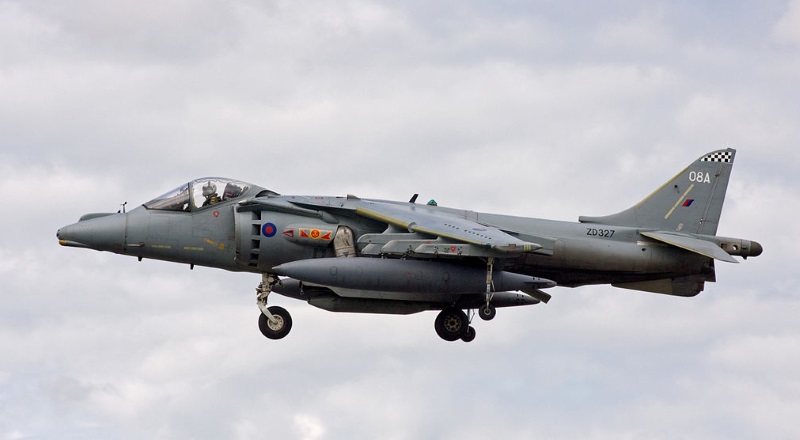
* The RAF's updated Harrier force was initially committed to "combat" of sorts in 1992, when they participated in Operation WARDEN, the British effort alongside the US Operation PROVIDE COMFORT, which was supposed to help protect Kurds in northern Iraq from Saddam Hussein. In fact, the RAF Harriers did little more than monitor Saddam Hussein's violations of the northern security zone.
This frustrating exercise did result in restoring a reconnaissance capability to the Harrier Force, which had been lost with the gradual withdrawal of the Harrier GR.3 from service. The new Harriers were initially fitted with the old reconnaissance pods -- which turned out to be a troublesome exercise, since it required a good deal of rewiring of the aircraft and training of the pilots for the reconnaissance mission. The old pods were later replaced with more modern Vinten reconnaissance pods of various types.
The RAF Harrier force was relieved of duty in Operation WARDEN by Tornados, but then, following up the service of British first-generation Harriers in the Balkan Wars, they were assigned to patrols over Bosnia in July 1995. They participated in air strikes as part of Operation DELIBERATE FORCE, the air campaign against Serb military targets from 30 August to 14 September 1995.
Beginning in 1997, the GR.7 was operationally deployed on Royal Navy carriers, providing strike capabilities while the Sea Harrier FA.2 ensured air superiority. This arrangement walked in the path of the Harrier GR.3 carrier deployments in the Falklands War and for a few years following. However, it became a much more official British policy, established with the formation of "Joint Force Harrier" in 2000, in which the RAF and Royal Navy Harriers were assembled into a common command structure as part of the British military's "Joint Rapid Deployment Force".
GR.7s were given with minor improvements for carrier operations, including a cockpit-mounted GPS receiver, presumably the Garmin 100 as used in the Shar; software improvements to the aircraft's INS to ease alignment on a rolling carrier deck; a new IFF transponder; and shift of the water replenishment point from the top of the aircraft to inside the undercarriage bay so that flight-deck crews would have easier and safer access.
* Embarrassingly, the GR.5 was never fully combat-capable and the GR.7 was only fully combat-capable in the mid-1990s. Although BAE had qualified a range of stores for these aircraft, the RAF had to perform their own qualifications, and the service was slow to deal with the matter. Part of the problem appears to have been bugs in aircraft system software that took a long time to work out.
Even as late as 1997, a senior RAF officer had to admit that "the aircraft is still getting clearances," though by that time the worst was well over. There had also been waffling on support of the TIALD advanced targeting pod, which allowed the GR.7 to designate its own laser-guided bombs, but that issue had been resolved by the mid-1990s, and TIALD was used by GR.7s to good effect over the Balkans.
After the NATO Kosovo air campaign in the spring of 1999, which demonstrated a greater need for a stand-off precision guided munitions, the RAF decided to qualify and support the US AGM-65D2G Maverick imaging infrared air-to-surface missile on the GR.7. Qualification trials were performed in 2000 and proved straightforward, as the Maverick had long been used on USMC Harrier IIs.
RAF Harrier GR,7s provided air support during the Anglo-American invasion of Iraq in the spring of 2003. Some of the aircraft carried Mavericks and improved "GPS enhanced" Paveway II laser-guided bombs, while a few carried a digital reconnaissance pod inherited from the Jaguar GR.3. Interestingly, Coalition cooperation was so tight that the GR.7s were mainly tasked with support of the US Army V Corps, though 30% of the Harrier missions were conducted in support of the USMC and British ground forces. RAF Harriers later flew combat operations in Afghanistan to support NATO forces trying to keep the peace there.
* The establishment of Joint Force Harrier and the desire to provide the GR.7 with improved capabilities led the UK to begin a program to upgrade the variant to the new "Harrier GR.9" specification. The path to this decision was somewhat convoluted. A GR.9 variant, roughly comparable to the USMC Harrier II Plus, had been considered for a number of years but had never made the cut. However, an engine update, in which 30 GR.7s were to be refitted with the "Pegasus 107" engine, was begun in the mid-1990s. The Pegasus 107 provided 196 kN (10,800 kgp / 23,800 lbf) thrust, 8% more than the Pegasus 105, and had improved reliability plus ease of maintenance.
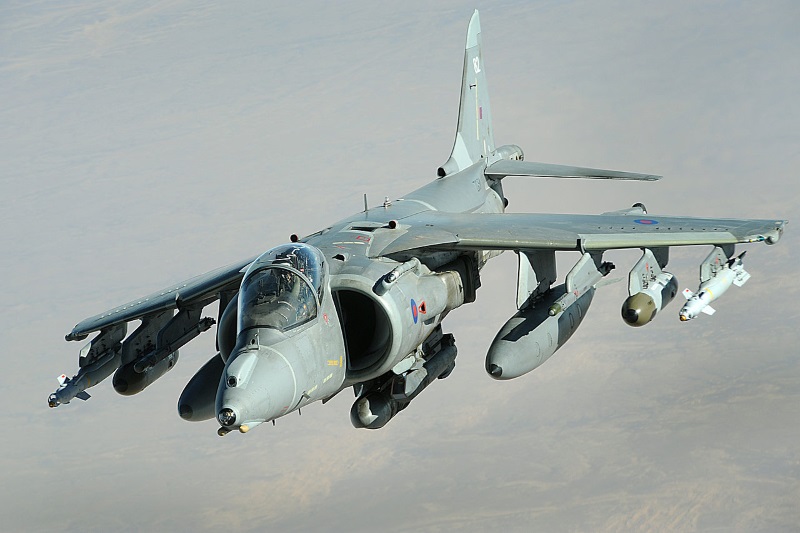
There was also a concern in the RAF with the fact that various upgrades had been applied in an inconsistent fashion across their Harriers, making maintenance troublesome, and suggesting the need to bring up all the Harriers to a uniform spec. The pressures towards updating the GR.7 finally reached a flashpoint with the establishment of Joint Force Harrier. The authorities decided that a mixed force of RAF GR.7s and FAA Shars simply wasn't on. As mentioned earlier, the Shars were phased out in 2006, with both the RAF and the FAA operating a common, improved Harrier II type. The retirement of the Shars with their AMRAAMs left a gap in fleet air defense, but that was to be plugged until the arrival of the F-35 JSF by the new Royal Navy "Type 45" air-defense escort destroyer, with the Aster / PAAMS surface-to-air missile system.
This common type was the GR.9, with 60 GR.7s to be upgraded to the spec. The core of the upgrade was a MIL-STD 1760 weapons databus and a new main computer system with modernized weapons software; a new GPS-INS navigation system; a ground-proximity warning system; and improved cockpit displays. A number were also wired for the TIALD pod. The first GR.9 was redelivered in late 2006, with the upgrade program completed in 2009. GR.9s were flying in combat in Afghanistan by early 2007. The 30 GR.7s fitted with the Pegasus 107 engine and upgraded to GR.9 specification were designated "GR.9A".
The improved fire-control system of the GR.9 permitted use of the new Marconi "Brimstone" anti-armor missile, an advanced derivative of the US Hellfire weapon; the Brimstone featured a millimeter-wave radar seeker that provided "fire and forget" capability, and was lightweight, allowing a GR.9 to carry nine such munitions. The GR.9 could also carry the "Advanced Short-Range AAM (ASRAAM)", a British successor to the traditional Sidewinder AAM with "off-boresight" targeting capability and comparable to the AIM-9X. GR.9 pilots didn't have a helmet-mounted sight, which would have been needed to make the best use of the ASRAAM.
* While the British considered an interim two-seat "T.6" trainer type, built by upgrading existing T.4s, to support GR.5/7 pilot training, on consideration such a measure did not seem very effective from either a cost or training point of view. They instead went to the TAV-8B with British avionics and called it the "T.10". The T.10, unlike the TAV-8B, was fully combat-capable. Initial flight was on 7 April 1994, with introduction into RAF service in March 1995. A total of 14 was acquired. Survivors were updated to "T.12" configuration to support the GR.9 fleet.
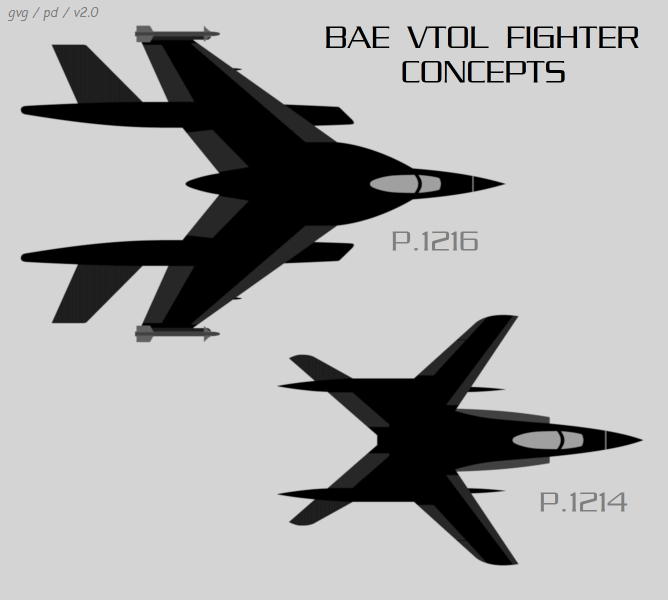
* BAE performed a number of studies of improved versions of the Harrier, then went on to consider a number of new-design V/STOL machines, some of them very exotic-looking. The ultimate decision was to join forces with the US on the F-35 JSF.
Joint Force Harrier would prove short-lived. In 2010, faced with budget shortfalls, the British government decided that the Harrier fleet would be retired in 2011, with the Panavia Tornado retained as a strike asset. The Royal Navy's carriers would be retired as well, once again leaving the Royal Navy without fleet air assets except for helicopters. Work was underway on two new carriers, however, to carry the F-35 JSF. Retirement of the GR.9 ended over 40 years of Harrier service with Britain's armed forces. All the airframes and spares were quickly bought up by the US Marines to keep the USMC Harrier II force flying.
BACK_TO_TOP* Several ingenious ideas were promoted by Harrier enthusiasts in the post-Falklands period to use the Harrier as a naval "force multiplier", based on unconventional substitutes for a traditional aircraft carrier.
One was called the "shipborne containerized air-defense system (SCADS)". This was a clever idea by which all the equipment needed to put together the operational apparatus of a small ski-jump Harrier carrier -- including living quarters, fuel and munitions storage, maintenance facilities, missile and decoy launchers, antisubmarine helicopter facilities, and of course a ski-jump deck -- would be built in a modular fashion, based on the standard container sizes used on container ships, and put in storage. The entire kit could be assembled in about two days on a container ship when needed, with provisions for 30 days of operation without resupply. The kit would be removed and stored again when the emergency was over.
An even cleverer idea was the "Skyhook". This concept was to use a crane that could be mounted on a small ship, such as a helicopter frigate, to lift Harriers off the deck and allow them to fly off, and then recover them later. On recovery, they could be returned to their deck hangar, or refueled while they dangled on the crane, and released to continue operations. The crane would be "smart", with stabilization capabilities and a panel indicator mounted to give the Harrier pilot location information. With such a system, a helicopter frigate could operate four Harriers as a kind of "mini-carrier".
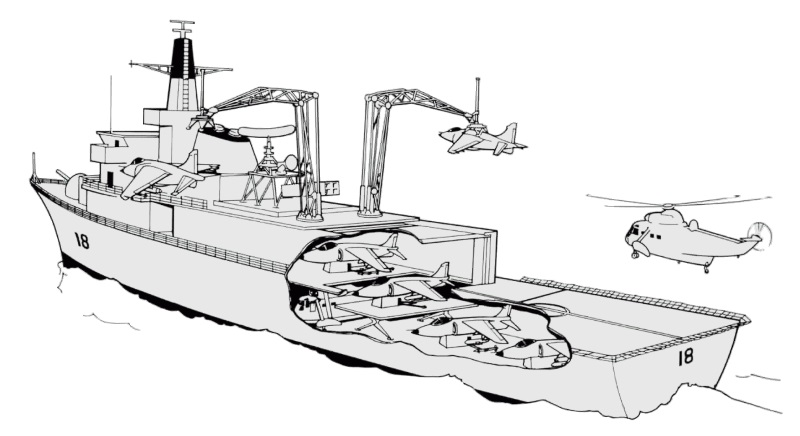
While British Aerospace experimented with the Skyhook on land using their G-VTOL demonstrator, neither SCADS nor the Skyhook became realities. Critics suggested that they implied a dispersal of forces that made logistics impractically difficult -- such "mini-carriers" being too "mini" to be practical.
* Another experimental evaluation program focused on the Harrier was conducted by the British military research establishment. This program was focused on making STOVL flight simpler for the pilot, and involved a modification of the second T.2 prototype with the tortured designation "Vectored-thrust Aircraft Advanced flight Control (VAAC)".
The VAAC Harrier was intended to consider solutions to the "three hands" problem of flying the type, where the pilot must handle throttle, stick, and nozzle angle lever during take-off and landing. The VAAC Harrier was fitted with a new cockpit and control system to allow the aircraft to be flown by pilots without special training. The control system was installed by the Cranfield Institute of Technology, Britain's foremost academic institution for aviation research. The T.2 was delivered to Cranfield in 1983, the modified aircraft made its first flight in 1985, and Cranfield handed it back to the Royal Aircraft Establishment for tests in 1986.
The aircraft still looked like a normal T.2 externally, except for the replacement of the cannon pods with featureless pods containing test avionics. The rear seat was given the new layout, while the front seat retained the old T.2 control layout. This allowed the aircraft to carry a test pilot in the back seat and a "safety pilot" in the front seat who could take over if the new control system went outside the envelope.
The VAAC Harrier was designed to be easily modified to allow testing of different cockpit layouts, control systems, and software, and it has been through many modifications. From 1995, the program came under the jurisdiction of the British "Defence Evaluation & Research Agency (DERA)", which had absorbed the RAE, though DERA was later disbanded into two new organizations -- a commercial organization named "QinetiQ" (pronounced "kinetic"), which inherited the VAAC Harrier in turn, and a government organization named the "Defence Science & Technology Laboratory (DSTL)".
The VAAC Harrier was strictly an experimental program and was not intended as a prototype for another Harrier update as such. However, it proved extremely useful for evaluating technologies to be used in the F-35 JSF. It performed its last flight in 2008.
BACK_TO_TOP* As the variant and production history of the Harrier is a little convoluted, it is useful to provide a summary. Harrier variants and production quantities include:
The Harrier was an interesting study in technology. While it was a remarkable invention in itself, its development progressed though a maze of bureaucratic obstacles, guided by a handful of visionaries who saw its potential. Most of the time, it went forward only by virtue of being the only available compromise. What the end users really wanted was a supersonic aircraft, and settled on the subsonic Harrier only when plans for bigger and faster aircraft fell through. However, the design proved effective and adaptable, as well as a source of many interesting ideas.
Despite its limitations, the Harrier was a great success, with an operational history of five decades, hundreds of aircraft produced, and users with the armed forces of six nations. It is surprising that change and growth in the field of STOVL aircraft has been so excruciatingly slow, only now resulting in the emergence of a second-generation operational STOVL fighter, the F-35 JSF.
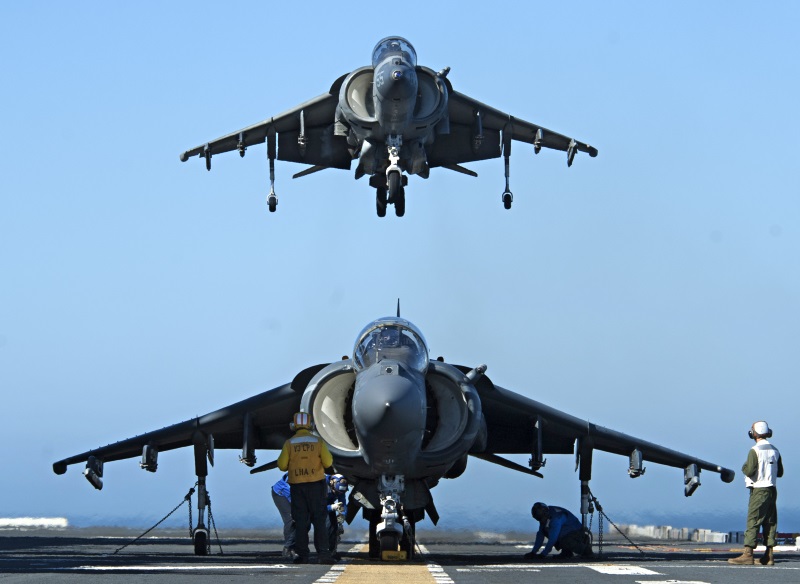
* I had the pleasure of watching a Harrier demonstration at an airshow in Corvallis, Oregon, in the mid-1980s. It was one of the more impressive sights I can recollect, made much more vivid by a great deal of noise and an overpowering smell of burning kerosene. It seemed, as the saying goes, to be a machine for converting fuel into noise.
Watching it hover was interesting, as it seemed less to float than to simply stand perched, screaming, on a cone of hot distorted air. However, the real thrill was watching it take off, rolling forward a few lengths and then bounding into the air, and then come back, slide to a hover, and then blast off again. I got to watch second-generation Harriers in action at the Miramar Marine Corps Air Station near San Diego in 2012; it wasn't quite as close-up an experience, but the Harriers still remained impressive.
* Sources include:
* Illustrations details:
* Revision history:
v1.0 / 01 dec 96 v1.1 / 09 dec 98 / Review & polish. v2.0.0 / 01 sep 01 / Major update, went to 3 chapters from 1. v2.0.1 / 01 may 02 / Added comments on Litening II, GR.9. v2.1.0 / 01 may 04 / General update, added stuff on 1950s UK VTOL. v2.1.1 / 01 apr 06 / Review & polish. v2.1.2 / 01 mar 08 / Review & polish. v2.1.3 / 01 jan 10 / Review & polish. v2.2.0 / 01 dec 11 / Chapter 3 reorg, final UK Harrier retirement. v2.2.1 / 01 nov 13 / USMC Harriers to 2030. v2.3.0 / 01 oct 15 / General update. v2.3.1 / 01 sep 17 / Review & polish. v2.4.0 / 01 aug 19 / Format update. v2.4.1 / 01 jul 21 / Review & polish. v2.5.0 / 01 may 23 / Review, update, & polish. v2.5.1 / 01 may 25 / Review & polish. (+)BACK_TO_TOP
